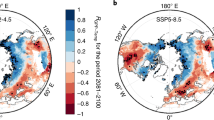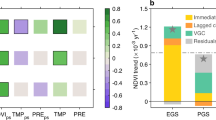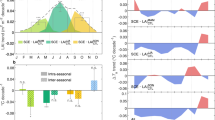Abstract
Warming is projected to increase the productivity of northern ecosystems. However, knowledge on whether the northward displacement of vegetation productivity isolines matches that of temperature isolines is still limited. Here we compared changes in the spatial patterns of vegetation productivity and temperature using the velocity of change concept, which expresses these two variables in the same unit of displacement per time. We show that across northern regions (>50° N), the average velocity of change in growing-season normalized difference vegetation index (NDVIGS, an indicator of vegetation productivity; 2.8 ± 1.1 km yr−1) is lower than that of growing-season mean temperature (T GS; 5.4 ± 1.0 km yr−1). In fact, the NDVIGS velocity was less than half of the T GS velocity in more than half of the study area, indicating that the northward movement of productivity isolines is much slower than that of temperature isolines across the majority of northern regions (about 80% of the area showed faster changes in temperature than productivity isolines). We tentatively attribute this mismatch between the velocities of productivity and temperature to the effects of limited resource availability and vegetation acclimation mechanisms. Analyses of ecosystem model simulations further suggested that limited nitrogen availability is a crucial obstacle for vegetation to track the warming trend.
This is a preview of subscription content, access via your institution
Access options
Access Nature and 54 other Nature Portfolio journals
Get Nature+, our best-value online-access subscription
$29.99 / 30 days
cancel any time
Subscribe to this journal
Receive 12 digital issues and online access to articles
$119.00 per year
only $9.92 per issue
Buy this article
- Purchase on Springer Link
- Instant access to full article PDF
Prices may be subject to local taxes which are calculated during checkout


Similar content being viewed by others
References
Rosenzweig, C. et al. in Climate Change 2007: Impacts, Adaptation and Vulnerability (eds Parry, M. L. et al.) 79–131 (Cambridge Univ. Press, Cambridge, 2007).
Elmendorf, S. C. et al. Plot-scale evidence of tundra vegetation change and links to recent summer warming. Nat. Clim. Change 2, 453–457 (2012).
Buitenwerf, R., Rose, L. & Higgins, S. I. Three decades of multi-dimensional change in global leaf phenology. Nat. Clim. Change 5, 364–368 (2015).
Vitasse, Y., Porté, A. J., Kremer, A., Michalet, R. & Delzon, S. Responses of canopy duration to temperature changes in four temperate tree species: relative contributions of spring and autumn leaf phenology. Oecologia 161, 187–198 (2009).
Wolkovich, E. M. et al. Warming experiments underpredict plant phenological responses to climate change. Nature 485, 494–497 (2012).
Wu, Z., Dijkstra, P., Koch, G. W., Peñuelas, J. & Hungate, B. A. Responses of terrestrial ecosystems to temperature and precipitation change: a meta-analysis of experimental manipulation. Glob. Change Biol. 17, 927–942 (2011).
Peñuelas, J. & Filella, I. Responses to a warming world. Science 294, 793–795 (2001).
Peñuelas, J. et al. Evidence of current impact of climate change on life: a walk from genes to the biosphere. Glob. Change Biol. 19, 2303–2338 (2013).
Hikosaka, K., Ishikawa, K., Borjigidai, A., Muller, O. & Onoda, Y. Temperature acclimation of photosynthesis: mechanisms involved in the changes in temperature dependence of photosynthetic rate. J. Exp. Bot. 57, 291–302 (2006).
Way, D. A. & Oren, R. Differential responses to changes in growth temperature between trees from different functional groups and biomes: a review and synthesis of data. Tree Physiol. 30, 669–688 (2010).
Zhu, Z. et al. Greening of the Earth and its drivers. Nat. Clim. Change 6, 791–795 (2016).
Thomas, R. Q., Canham, C. D., Weathers, K. C. & Goodale, C. L. Increased tree carbon storage in response to nitrogen deposition in the US. Nat. Geosci. 3, 13–17 (2010).
Loarie, S. R. et al. The velocity of climate change. Nature 462, 1052–1055 (2009).
Ackerly, D. et al. The geography of climate change: implications for conservation biogeography. Divers. Distrib. 16, 476–487 (2010).
Burrows, M. T. et al. The pace of shifting climate in marine and terrestrial ecosystems. Science 334, 652–655 (2011).
Burrows, M. T. et al. Geographical limits to species-range shifts are suggested by climate velocity. Nature 507, 492–495 (2014).
Diffenbaugh, N. S. & Field, C. B. Changes in ecologically critical terrestrial climate conditions. Science 341, 486–492 (2013).
Dobrowski, S. Z. et al. The climate velocity of the contiguous United States during the 20th century. Glob. Change Biol. 19, 241–251 (2013).
Sandel, B. et al. The influence of Late Quaternary climate-change velocity on species endemism. Science 334, 660–664 (2011).
Bi, J., Xu, L., Samanta, A., Zhu, Z. & Myneni, R. Divergent Arctic–boreal vegetation changes between North America and Eurasia over the past 30 years. Remote Sens. 5, 2093–2112 (2013).
LoPresti, A. et al. Rate and velocity of climate change caused by cumulative carbon emissions. Environ. Res. Lett. 10, 095001 (2015).
Lucht, W. et al. Climatic control of the high-latitude vegetation greening trend and Pinatubo effect. Science 296, 1687–1689 (2002).
Myneni, R. B., Keeling, C. D., Tucker, C. J., Asrar, G. & Nemani, R. R. Increased plant growth in the northern high latitudes from 1981 to 1991. Nature 386, 698–702 (1997).
Hickler, T. et al. CO2 fertilization in temperate FACE experiments not representative of boreal and tropical forests. Glob. Change Biol. 14, 1531–1542 (2008).
Schimel, D., Stephens, B. B. & Fisher, J. B. Effect of increasing CO2 on the terrestrial carbon cycle. Proc. Natl Acad. Sci. USA 112, 436–441 (2015).
Granath, G. et al. Photosynthetic performance in Sphagnum transplanted along a latitudinal nitrogen deposition gradient. Oecologia 159, 705–715 (2009).
Livingston, N. J., Guy, R. D., Sun, Z. J. & Ethier, G. J. The effects of nitrogen stress on the stable carbon isotope composition, productivity and water use efficiency of white spruce (Picea glauca (Moench) Voss) seedlings. Plant Cell Environ. 22, 281–289 (1999).
Kimball, J. S. et al. Recent climate-driven increases in vegetation productivity for the western Arctic: evidence of an acceleration of the northern terrestrial carbon cycle. Earth Interact. 11, 1–30 (2007).
Xia, J. et al. Joint control of terrestrial gross primary productivity by plant phenology and physiology. Proc. Natl Acad. Sci. USA 112, 2788–2793 (2015).
Forkel, M. et al. Codominant water control on global interannual variability and trends in land surface phenology and greenness. Glob. Change Biol. 21, 3414–3435 (2015).
Fu, Y. H. et al. Declining global warming effects on the phenology of spring leaf unfolding. Nature 526, 104–107 (2015).
Laube, J. et al. Chilling outweighs photoperiod in preventing precocious spring development. Glob. Change Biol. 20, 170–182 (2014).
Zhang, X., Tarpley, D. & Sullivan, J. T. Diverse responses of vegetation phenology to a warming climate. Geophys. Res. Lett. 34, L19405 (2007).
Barichivich, J. et al. Large-scale variations in the vegetation growing season and annual cycle of atmospheric CO2 at high northern latitudes from 1950 to 2011. Glob. Change Biol. 19, 3167–3183 (2013).
Liu, Q. et al. Temperature, precipitation, and insolation effects on autumn vegetation phenology in temperate China. Glob. Change Biol. 22, 644–655 (2016).
Gepstein, S. & Thimann, K. V. Changes in the abscisic acid content of oat leaves during senescence. Proc. Natl Acad. Sci. USA 77, 2050–2053 (1980).
Nemani, R. R. et al. Climate-driven increases in global terrestrial net primary production from 1982 to 1999. Science 300, 1560–1563 (2003).
Melillo, J. M. et al. Soil warming, carbon–nitrogen interactions, and forest carbon budgets. Proc. Natl Acad. Sci. USA 108, 9508–9512 (2011).
Frost, G. V. & Epstein, H. E. Tall shrub and tree expansion in Siberian tundra ecotones since the 1960s. Glob. Change Biol. 20, 1264–1277 (2014).
Sitch, S. et al. Evaluation of the terrestrial carbon cycle, future plant geography and climate–carbon cycle feedbacks using five dynamic global vegetation models (DGVMs). Glob. Change Biol. 14, 2015–2039 (2008).
Fisher, J. B., Badgley, G. & Blyth, E. Global nutrient limitation in terrestrial vegetation. Glob. Biogeochem. Cycles 26, GB1014 (2012).
Smith, N. G. & Dukes, J. S. Plant respiration and photosynthesis in global-scale models: incorporating acclimation to temperature and CO2. Glob. Change Biol. 19, 45–63 (2013).
Likens, G. Long-term Studies in Ecology (Springer, New York, 1989).
Jung, M. et al. Global patterns of land–atmosphere fluxes of carbon dioxide, latent heat, and sensible heat derived from eddy covariance, satellite, and meteorological observations. J. Geophys. Res. Biogeosci. 116, G00J07 (2011).
Weedon, G. P. et al. The WFDEI meteorological forcing data set: WATCH Forcing Data methodology applied to ERA-Interim reanalysis data. Water. Resour. Res. 50, 7505–7514 (2014).
Pinzon, J. E. & Tucker, C. J. A non-stationary 1981–2012 AVHRR NDVI3g time series. Remote Sens. 6, 6929–6960 (2014).
Huete, A. et al. Overview of the radiometric and biophysical performance of the MODIS vegetation indices. Remote Sens. Environ. 83, 195–213 (2002).
Smith, W. K. et al. Large divergence of satellite and Earth system model estimates of global terrestrial CO2 fertilization. Nat. Clim. Change 6, 306–310 (2016).
Cong, N. et al. Changes in satellite-derived spring vegetation green-up date and its linkage to climate in China from 1982 to 2010: a multimethod analysis. Glob. Change Biol. 19, 881–891 (2013).
Piao, S., Fang, J., Zhou, L., Ciais, P. & Zhu, B. Variations in satellite-derived phenology in China’s temperate vegetation. Glob. Change Biol. 12, 672–685 (2006).
White, M. A. et al. Intercomparison, interpretation, and assessment of spring phenology in North America estimated from remote sensing for 1982–2006. Glob. Change Biol. 15, 2335–2359 (2009).
Zheng, B., Chenu, K. & Chapman, S. C. Velocity of temperature and flowering time in wheat-assisting breeders to keep pace with climate change. Glob. Change Biol. 22, 921–933 (2016).
Fensholt, R. & Proud, S. R. Evaluation of earth observation based global long term vegetation trends—comparing GIMMS and MODIS global NDVI time series. Remote Sens. Environ. 119, 131–147 (2012).
Piao, S. et al. Leaf onset in the Northern Hemisphere triggered by daytime temperature. Nat. Commun. 6, 6911 (2015).
Jeong, S., Ho, C.-H., Gim, H.-J. & Brown, M. E. Phenology shifts at start vs. end of growing season in temperate vegetation over the Northern Hemisphere for the period 1982–2008. Glob. Change Biol. 17, 2385–2399 (2011).
Acknowledgements
This study was supported by National Natural Science Foundation of China (41530528), and the 111 Project (B14001). I.A.J., P.C. and J.P. were supported by the European Research Council Synergy grant SyG-2013-610028 IMBALANCE-P.
Author information
Authors and Affiliations
Contributions
S.Pi. designed research; M.H. performed analysis; and all authors contributed to the interpretation of the results and the writing of the paper.
Corresponding author
Ethics declarations
Competing interests
The authors declare no competing financial interests.
Additional information
Publisher’s note: Springer Nature remains neutral with regard to jurisdictional claims in published maps and institutional affiliations.
Electronic supplementary material
Supplementary Information
Supplementary Methods, Supplementary Description, Supplementary Figures 1–17, Supplementary Tables 1–3, and references
Rights and permissions
About this article
Cite this article
Huang, M., Piao, S., Janssens, I.A. et al. Velocity of change in vegetation productivity over northern high latitudes. Nat Ecol Evol 1, 1649–1654 (2017). https://doi.org/10.1038/s41559-017-0328-y
Received:
Accepted:
Published:
Issue Date:
DOI: https://doi.org/10.1038/s41559-017-0328-y
This article is cited by
-
Spatial variability in herbaceous plant phenology is mostly explained by variability in temperature but also by photoperiod and functional traits
International Journal of Biometeorology (2024)
-
Enhanced soil moisture improves vegetation growth in an arid grassland of Inner Mongolia Autonomous Region, China
Journal of Arid Land (2023)
-
Accurate phenology analyses require bud traits and energy budgets
Nature Plants (2022)
-
Light limitation regulates the response of autumn terrestrial carbon uptake to warming
Nature Climate Change (2020)
-
High Arctic ecosystem states: Conceptual models of vegetation change to guide long-term monitoring and research
Ambio (2020)



